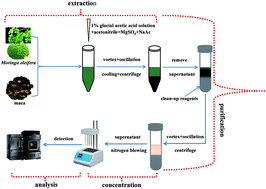Screening of multiclass pesticide residues in maca and Moringa oleifera by a modified QuEChERS sample preparation procedure and UPLC-ESI-MS/MS analysis
Abstract
In the present study, a modified QuEChERS (quick, easy, cheap, effective, rugged, and safe) method was proposed for the simultaneous analysis of 75 pesticides in maca and Moringa oleifera with ultra-performance liquid chromatography-electrospray ionization-tandem mass spectrometry (UPLC-ESI-MS/MS). The developed method was validated in accordance with linearity, linear range, limit of detection, limit of quantification, accuracy, precision, and matrix effect. Each analyte had good linearity (R2 > 0.99) in the corresponding concentration range. The method LOD and LOQ values of all the analytes ranged from 0.01 μg kg−1 to 303.35 μg kg−1 and 0.03 μg kg−1 to 1011.15 μg kg−1, respectively. The recoveries (n = 6) of the analyzed pesticides were in the range of 75.92–113.43%. The RSDs of precision were between 0.60% and 7.36%. All matrix effect values ranged from 81.79% to 118.71% and 80.36% to 119.64% in maca and Moringa oleifera, respectively. The analysis of 103 samples showed the presence of isofenphos-methyl in some of them. The method had a good application prospect and could be used as a general approach for the quantitative determination of pesticide residues in food.



 Please wait while we load your content...
Please wait while we load your content...